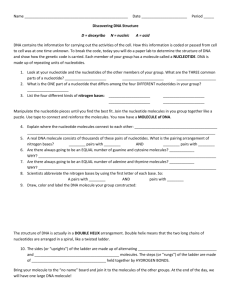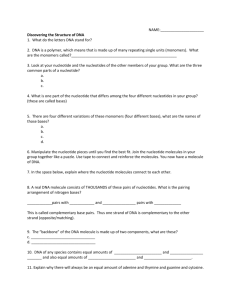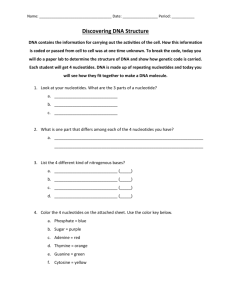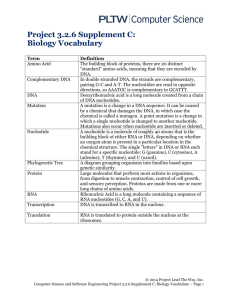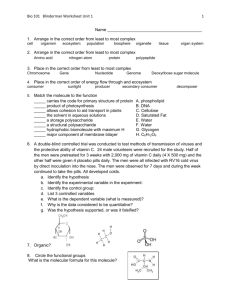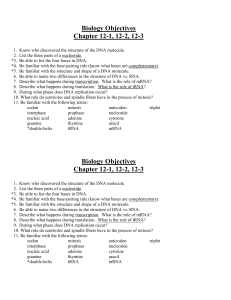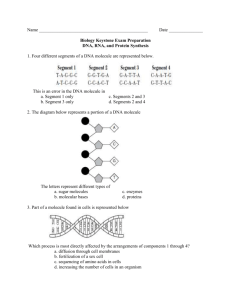DNA Structure Worksheet: Discovering the Genetic Code
advertisement
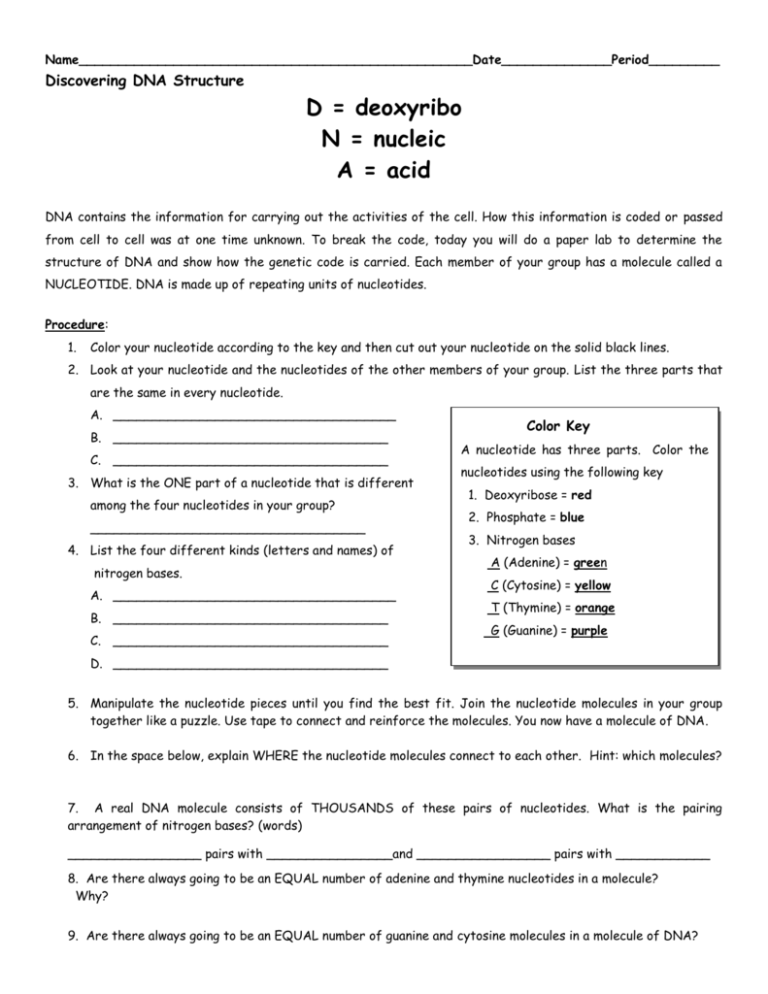
Name__________________________________________________Date______________Period_________ Discovering DNA Structure D = deoxyribo N = nucleic A = acid DNA contains the information for carrying out the activities of the cell. How this information is coded or passed from cell to cell was at one time unknown. To break the code, today you will do a paper lab to determine the structure of DNA and show how the genetic code is carried. Each member of your group has a molecule called a NUCLEOTIDE. DNA is made up of repeating units of nucleotides. Procedure: 1. Color your nucleotide according to the key and then cut out your nucleotide on the solid black lines. 2. Look at your nucleotide and the nucleotides of the other members of your group. List the three parts that are the same in every nucleotide. A. ____________________________________ B. ___________________________________ C. ___________________________________ 3. What is the ONE part of a nucleotide that is different among the four nucleotides in your group? ___________________________________ 4. List the four different kinds (letters and names) of nitrogen bases. A. ____________________________________ B. ___________________________________ C. ___________________________________ Color Key A nucleotide has three parts. Color the nucleotides using the following key 1. Deoxyribose = red 2. Phosphate = blue 3. Nitrogen bases A (Adenine) = green C (Cytosine) = yellow T (Thymine) = orange G (Guanine) = purple D. ___________________________________ 5. Manipulate the nucleotide pieces until you find the best fit. Join the nucleotide molecules in your group together like a puzzle. Use tape to connect and reinforce the molecules. You now have a molecule of DNA. 6. In the space below, explain WHERE the nucleotide molecules connect to each other. Hint: which molecules? 7. A real DNA molecule consists of THOUSANDS of these pairs of nucleotides. What is the pairing arrangement of nitrogen bases? (words) _________________ pairs with ________________and _________________ pairs with ____________ 8. Are there always going to be an EQUAL number of adenine and thymine nucleotides in a molecule? Why? 9. Are there always going to be an EQUAL number of guanine and cytosine molecules in a molecule of DNA? Why? 10. Scientists abbreviate the nitrogen bases by using the first letter of each base. So, A always binds to____ G always binds to ____ 11. In the space below, use the letters to show the sequence (order) of the bases in the DNA molecule that your group constructed. Begin at the top left side of your molecule. ____goes with____ ____goes with ____ 12. The structure of DNA is actually in a DOUBLE HELIX arrangement. In the DNA molecule below, circle one nucleotide. Label the parts of the nucleotide you listed in number 2. DOUBLE HELIX means that the two long chains of nucleotides are arranged in a spiral like a twisted ladder. 13. The sides (or "uprights") of the ladder are made up of alternating ___________________ and ___________________ molecules. These are very strong covalent bonds. The steps (or "rungs") of the ladder are made of __________________ _____________________held together by HYDROGEN BONDS. Hydrogen bonds are weak. Why do you think that it may be important for hydrogen bonds to be relatively weak? 14. Bring your molecule to the front of the room and join it to the molecules of the other groups. We now have one large DNA molecule. 15. Copy the DNA code (sequence) for this classroom,s DNA molecule that was created. 16. Is the sequence (code) the same as the code created by the previous class? How are the two DNA molecules different? It is the sequence of the nitrogenous bases in the DNA that codes for different proteins that are made. 18. Do you think the different classrooms’ DNA structures will have coded for (created) the same proteins?
